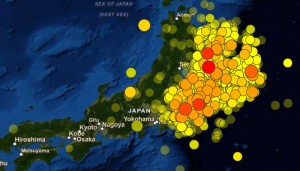A year ago tonight, I was indulging in a routine: Having finished my evening's work at KQED News, I was home watching KTVU-Channel 2's "Ten O'Clock News." (Yes, unwinding after work by taking in more news.) About 15 minutes into the show, one of the anchors said a powerful earthquake had been reported in the Pacific near Japan. The first thing I thought: They just had a pretty big earthquake right there (and looking back now, that earlier quake was a 7.3, about 100 miles east of the city of Sendai. As best I can recall, it caused no damage or tsunami).

A while later, the show aired live video from Japanese TV. The anchors weren't clear on where in Japan the pictures were from or what they showed. What you could see was an urban scene, with traffic stopped on a large bridge in the distance—that was all. A few minutes later, the same scene. This time, you could see something flowing under the bridge—debris, boats, even small buildings. It was hard to make sense of what was going on or to understand just what that brief glimpse of an unknown city in Japan might mean.
Then at some point late in the hour, the anchor read a magnitude estimate: 8.8. I thought immediately of the 8.8 quake that struck off the coast of Chile in February 2010, damaging cities hundreds of miles from the epicenter, unleashing tsunamis, and killing more than 500 people. This new quake would be devastating if it was anywhere near Japan's coast.
I called my son and daughter-in-law in the South Bay. Sakura is from Ibaraki Prefecture, north of Tokyo, and I just wanted to see if they had heard about the earthquake. They hadn't yet, and Sakura started trying to contact her family (she soon found out that the family home, about 180 miles from the epicenter, had suffered violent shaking, but no major damage).
I've long since become a victim of CNN fatigue, but this night I switched to cable news after the local news ended. The meaning of those first enigmatic pictures became instantly clear: a tsunami of unimaginable power was ravaging the coast of northeastern Japan. Every news channel showed views of water rushing across fields and highways, smashing harbors, even inundating an airport. The waves were dismantling villages. In larger towns, whole neighborhoods seemed to be on the move. I wrote an item for News Fix wrapping up some of the notable coverage I was seeing and posted it at midnight. At this point, the story was still something happening on the other side of the world.